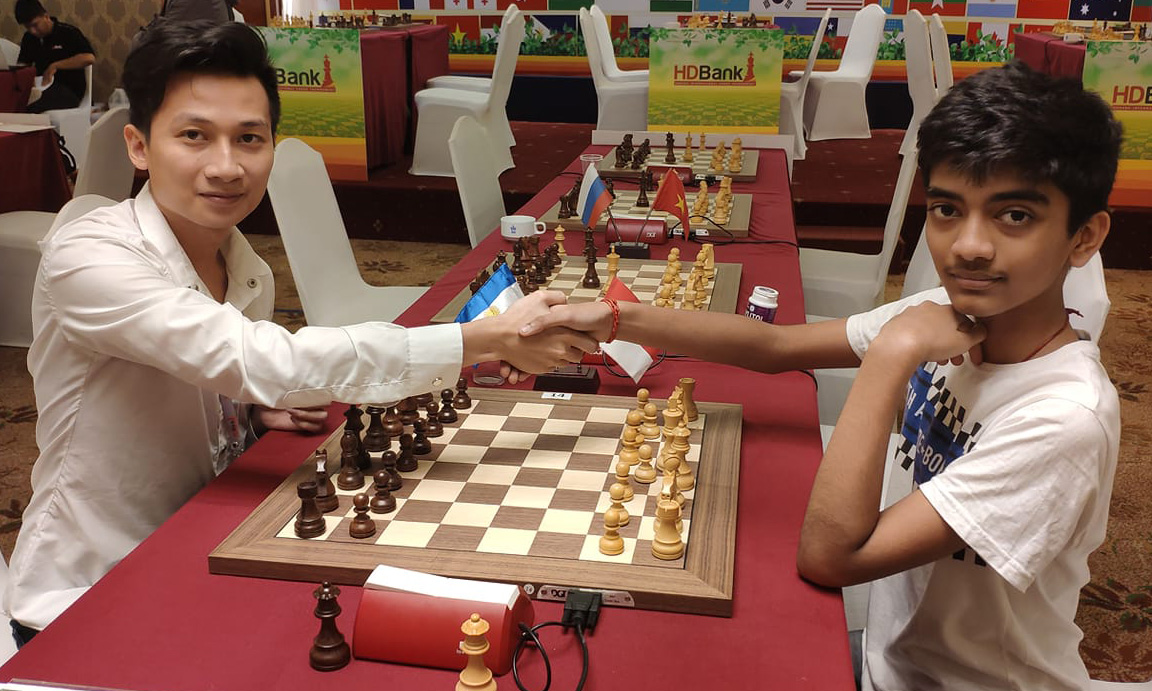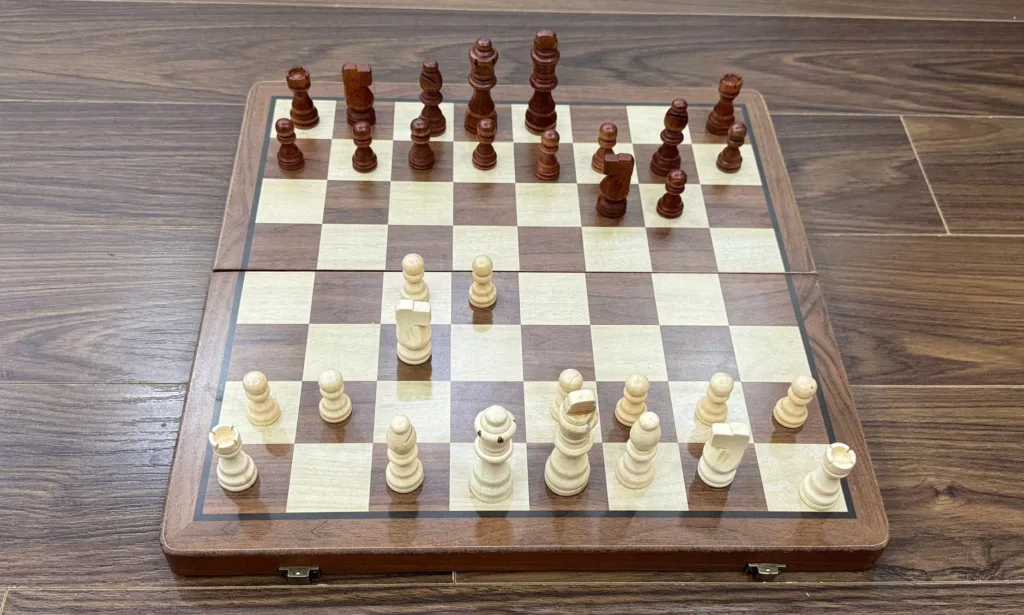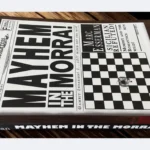The King’s Indian Defense (KID) is one of the boldest responses Black can choose against 1.d4. Instead of fighting for the center right away, Black invites White to occupy it, only to strike back later with calculated fury.
It begins:
- d4 Nf6
- c4 g6
- Nc3 Bg7
At this point, White is happy to expand. “Fine!” says White, “If you’re giving me space, I’ll take it. Attack me if you dare. I’ll crush you.” Black, on the other hand, remains calm: “Go ahead. Build your pretty pawn center. The bigger it gets, the more I’ll enjoy tearing it apart, either with …e5 or …c5, and always with my Bg7 ready to join the assault.”
- The Main Continuation
- Two Typical Pawn Structures
- Key Strategic Ideas
- Classical Variation
- Saemisch Variation
- Four Pawns Attack
- Fianchetto Variation
- Bonus: The Modern Benoni
- Final Thoughts
The Main Continuation
Most of the time, White accepts the invitation to grab space with 4.e4, and Black replies with 4…d6, followed by castling. Soon, the center becomes the battleground.
Typical follow-up:
- Nf3 0-0
- Be2 e5
Now White has options:
- Exchange pawns: 7.dxe5 dxe5 8.Nxe5 Nxe4! A slick move that unveils the power of the Bg7.
- Push: 7.d5 – gaining more space and closing the center.
- Wait: 7.0-0, then decide based on Black’s next move.
In most serious games, White eventually goes for 7.0-0 and 8.d5. Black will usually respond with 7…Nc6 and 8…Ne7, keeping flexibility and eyeing kingside counterplay.
Two Typical Pawn Structures
Structure 1 – After …e5 and d4-d5:
Black’s break is …f5. White might reply with f3, building a solid wall. Black can play …f4, aiming to storm the kingside. Meanwhile, White plays for c4-c5 and invasion on the queenside or a favorable endgame where Black’s dark-squared bishop is a prisoner of its own pawns.
Structure 2 – After …c5 and d4-d5:
Black’s central break is …e6; the queenside break is …b5, often a pawn sacrifice for activity. White’s thematic push is e4-e5, usually prepared with f4. Both sides play on different wings, creating dynamic tension.
Key Strategic Ideas
White’s Ideas:
- If you lock the center with d4-d5, then carry out your break (usually c4-c5 or e4-e5) efficiently.
- Don’t close the position on the side you’re attacking.
- If Black has played …e5 and you’ve played d5, aim for an endgame. Black’s bishop on g7 can become weak.
- Keep pieces on the board when you have more space.
- Sometimes e4xf5 is playable, but make sure Black’s Bg7 doesn’t come alive.
- If you play Be3 and Qd2, make sure f3 or h3 is covered to stop Ng4.
Black’s Ideas:
- If White locks the center with d5, start your break quickly…f5 or …c5.
- Don’t close the position on your own attacking flank.
- After e4xf5, recapture with the g-pawn, keep pieces aimed at White’s king.
- Use a pawn sacrifice to activate the Bg7 if needed.
- If White replies f3 to …f5, unleash your kingside pawns (…g5, …h5) and consider sacrificing material to break through.
- If White plays Be3 early, consider …Ng4, it’s often the most direct punishment.
Classical Variation
- d4 Nf6
- c4 g6
- Nc3 Bg7
- e4 d6
- Nf3 0-0
- Be2 e5
- 0-0 Nc6
- d5 Ne7
This is the main line, where both sides are fully committed. If White had tried 7.dxe5, after 7…dxe5 8.Nxe5, Black strikes with 8…Nxe4!, revealing the power of the Bg7 again. 7.dxe5 is playable, but often leads to equality, less exciting than the rich complexity of the main line.
Saemisch Variation
- d4 Nf6
- c4 g6
- Nc3 Bg7
- e4 d6
- f3 0-0
This setup is solid and aggressive. White strengthens the center and prepares for a potential kingside storm: Be3, Qd2, 0-0-0, h4, g4, Bh6, like in the Sicilian Dragon. Black must be ready: options include …e5 or …Nc6 with …a6, followed by …b5 or …Re8.
Four Pawns Attack
- d4 Nf6
- c4 g6
- Nc3 Bg7
- e4 d6
- f4 0-0
- Nf3
A brutal setup. White throws four pawns into the center. Black’s safest line is 6…c5, and if 7.d5, then 7…e6, challenging the center before it becomes overwhelming. Without accurate play, Black can easily get overrun.
Fianchetto Variation
- d4 Nf6
- c4 g6
- Nf3 Bg7
- g3 d6
- Bg2 0-0
- 0-0
This is a calm, positional setup. White doesn’t rush the center but develops safely. Black can choose …Nd7 (for …e5), …c5, or …Nc6 depending on the game’s direction. It’s less aggressive but often more flexible.
Bonus: The Modern Benoni
A cousin of the King’s Indian that flips the move order:
- d4 Nf6
- c4 c5
- d5 e6
- Nc3 exd5
- cxd5 d6
Now, Black fianchettos the bishop and fights from the queenside and center. Pawn breaks like …b5 or pressure along the e-file and diagonal give Black play despite the space disadvantage.
Final Thoughts
The King’s Indian Defense is not for the faint of heart. It gives up space and requires trust in your counterattack. But if you enjoy dynamic positions, where initiative and timing matter more than raw material or symmetry, the KID may become your favorite defense.
Play it with courage. Attack with conviction. Whether you’re White trying to push your space advantage, or Black building energy behind a cramped setup, this is chess at its most combative.

I’m Xuan Binh, the founder of Attacking Chess, and the Deputy Head of Communications at the Vietnam Chess Federation (VCF). My chess.com and lichess rating is above 2300. Send me a challenge or message via Lichess. Follow me on Twitter (X) or Facebook.







1 thought on “King’s Indian Defense: The Art of Counterattack in Chess”
Comments are closed.